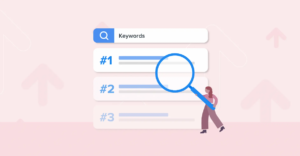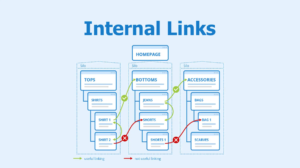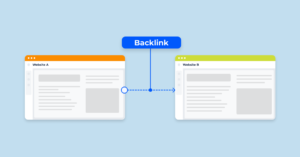Introduction
There were over 8.5 billion searches made on Google between February and April 2023, proving there’s a lot of activity online. As AI advances at an unprecedented pace, it’s important to stay ahead of the curve and make sure you’re following the latest SEO best practices. Mastering SEO is crucial for businesses and individuals looking to stand out in this crowded digital world. Rankings matter, with the first position achieving a click-through rate (CTR) of 27.6%, while the 10th position sees just 2.4%. You have to optimize for SEO. Boost your digital presence with these 12 essential SEO best practices.
1. Make sure your keywords are searchable
Choosing keywords with enough search potential is importantÂ
You need to identify low-hanging fruit: keywords and phrases with low competition and high search volume. If you go after this, your content will reach a wider audience and rank better. You can find search volume data in your browser with a tool like Surfer’s free Chrome extension. The other side is also true.

SEO 12 Best Practices To Rank Content Higher
Getting highly competitive keywords isn’t easy because you’re up against big brands. Those terms aren’t impossible to rank, but it’s not easy, and there may be better opportunities. Your goal is to find the keywords that best describe your services and products, so you can write authoritative content about them.
Your website can gain more organic traffic, increase visitor numbers, and possibly boost conversion rates with high-quality content built around strategically chosen keywords. That’s a win, right?
Topics you can relate to
It’s also important to pick realistic topics that are relevant to your brand when choosing keywords. Analyze your competition and figure out what they’re doing right and what they’re doing wrong. You’ll then be able to pick topics that work for you based on your business. Considering keyword difficulty is also important. While seed keywords are the most popular, long-tail keywords are more relevant to your site. There’s a better chance they’ll attract a more specific audience. Google Search Console has a queries report that you can use to figure out what keywords are ranking well. Create content for related keywords.
2. Find out what searchers are looking for
SEO also involves understanding and meeting search intent (also called user intent or keyword intent).Â

SEO 12 Best Practices To Rank Content Higher
Search intent should be matched with the content you create
It’s best explained by Authority Hacker’s Gael Breton:It’s impossible to rank if you don’t check and align with the user’s intent.
It’s all about what the searcher is looking for. How do they want to do it?ÂHow do they feel about learning something, buying something, doing something, or going somewhere?Ensure your content matches the user’s intent so you rank higher in search results once you understand what they’re trying to accomplish. It’s important to note that although there are four types of user intent, they’re often worded differently.
Here’s what I’m sharing
People search for informational keywords in Google to learn something. You have to make sure your blog posts, glossary terms, FAQs, and research papers match their search.
Here are some examples of queries with informational intent:
What is X?
Definition of X
Examples of X
Intentions to make money
Depending on how much you know about the topic, you might act on it. Keywords with commercial intent are process-oriented and “do”-oriented. It’s now up to the searchers how they want to move forward, and the content you create needs to match that intent.
An example of commercial content is in-depth tutorials and guides.
You can search for “apply for a credit card” on Google and other engines.Â
That’s exactly what it shows you.
Intent of transaction
When someone uses transactional keywords, they’re looking to buy. They’ve decided they’re ready to buy, so they’re narrowing their options, getting validation, and finalizing their decision.
Make sure your content matches these types of transactional intent queries, like broad landing pages, product and service pages, and testimonials:
best X
X vs Y comparison
X reviews
Google understands your search for “best family tents” and will give you nine of them (with the option to load more). Reviews help you narrow down your decision so you can go ahead and buy.
The purpose of navigation
Those are navigational intent queries: they want to go somewhere specific, like an online store. When people use navigational keywords, they often have a brand in mind, so make sure your brand is on top of the results. A navigational search related to a brand makes the searcher more likely to buy.
3. Make sure you use your primary keyword

SEO 12 Best Practices To Rank Content Higher
The primary keyword or target keyword must be incorporated effectively for SEO success. If you want to rank your content, this keyword should represent what your post is about.
Make sure you use your main keyword in these 4 places:
The H1 page title should have the keyword at the beginning:When you can see that your headline matches what they’re searching for, your chances of them clicking on your site are higher.
Header tags:These are the tags you put in your web pages to structure your content. To help search engines understand your content, include your main keyword and variations in some header tags, like H2 and H3.
In search results, your meta description will appear with your page and meta title: You’re telling readers what your content is about and whether it’ll help them. Include your key words in your description.Â
URLs: Use your main keyword in the URL to tell readers and search engines what your page is about.Â
Your URLs should be SEO-friendly. The main keyword for our pillar page “Keyword Research Ultimate Guide: Step-by-Step Strategies for More Traffic” is “keyword research.” Keywords appear prominently in the page title, meta tag, meta description, header tags, and URL of the article.
4. Put secondary keywords in your content
Using secondary keywords in your content will help search engines understand your content better.Â
Google uses secondary keywords to identify related entities on your page since they signal semantic relationships.

SEO 12 Best Practices To Rank Content Higher
If you have these three elements in your article, your search engine will see that you’ve written a well-rounded article about your main keyword in a thorough manner. Your article will be more likely to rank higher in search engine results. Additionally, your readers will have a better understanding of your topic. Finally, your article will be more likely to attract backlinks from other websites.Â
5. Get your titles and meta descriptions right
To improve CTR and make it easy for users and search engines to understand your content, write compelling titles and meta descriptions. It’s best to keep titles under 60 characters and meta descriptions under 150-160 characters to maximize CTR. Don’t forget accessibility, brevity, and capturing quality when crafting titles and meta descriptions. You should capitalize every word in titles.

SEO 12 Best Practices To Rank Content Higher
It’s like an elevator pitch, and it should make the searcher think your page is exactly what they’re looking for.
Make your title and description catchy so people click on it in search engine results. You can get a lot of traffic from search engines with a good title and meta description. The title and description of this page are good examples. There’s a lot of information in the meta description.
6. Put internal links in
Your website’s SEO performance depends on internal links, which connect pages within a website to other pages within the same domain.You can help search engines understand the relationship between your content pieces by adding internal and external links.ÂAs well as establishing a site hierarchy, internal links improve your PageRank. Readers can also find extra resources there.

SEO 12 Best Practices To Rank Content Higher
What are the benefits of internal links?
A link acts as a vote of confidence for a search engine. Internal links can also help search engines figure out which pages to prioritize, even though external links are the strongest indicator.
Your website’s content is discovered by search crawlers through links. Linking to a page on your website basically tells search engines this is an important page. To optimize your internal linking, here are a few tips: Use links within related pages in a topic cluster to signal a content hub. It’ll help your topical authority and ensure your links are semantically related. The older content on your site has more authority, so link to newer pages from the older content.Â
Make your anchor text fun
Don’t link to everything. If you’re a new site, link to pages within your topic. There’s no problem linking to pages outside the topic cluster on authority sites.Â
Be sure all your web pages are linked so you don’t have any pages without internal links. Your website’s content will be harder to find, crawl, and index if no pages link to it.
Include external links. Your standing can go up if you’re associated with credible sites.Â
7. Link to your siteÂ
Your SEO strategy needs to include backlinks, a confirmed ranking factor. When a website has fewer or no backlinks, it’s like an island in the vast internet ocean. These websites are harder for search engines to find and index, so they’re less likely to show up in search results.

SEO 12 Best Practices To Rank Content Higher
A lack of visibility can lead to fewer visitors, less brand exposure, and lower revenue. When a website links to yours, search engines know your content is good. Your website’s SEO ranking will go up. Moreover, backlinks can drive direct traffic to your site, increasing your audience and potential customers.
You can get backlinks to by:Â Â
Content that’s shareable and high-quality
Blogging on reputable sites as a guest
Getting in touch with influencers and relevant websites
Media outreach like press releases and HARO-style press releases.
8. Keep your readers interested
If you make content your audience won’t enjoy or find helpful, they’ll leave your website quickly.Your audience will only spend time on your website if you create helpful, valuable, and original content.Â

SEO 12 Best Practices To Rank Content Higher
You can also boost your search rankings when you write compelling, optimized content that meets Google’s quality guidelines.Content needs to resonate with your target audience, and you can only do that when you know their needs, preferences, and search intent.Â
Here’s what you should do when writing SEO content
Your content should be skimmable:Most readers skim content to find what they’re looking for, so you should use white space, make your content skimmable with short paragraphs, and include formatting.
Use headers and subheaders:They categorize your content and make it easier to skim. Make sure your headers and subheads accurately summarize the following content sections so readers stay on your page.
Don’t be afraid to use images:It’s true what they say, “A picture is worth a thousand words.” Use images, infographics, videos, GIFs, and screenshots whenever you can, and make them SEO-friendly.
Optimize for mobile:More than 55% of searches go to mobile devices compared to 43% for desktops. Optimizing your website for mobile is essential.Â
You should be able to read the content on a smaller screen Buttons and links should be tapable Don’t fill your page with text. If your content is informative, visually appealing, commercially viable, and user-friendly, you can provide an enjoyable experience for your readers while satisfying search engines.
9. Make it E-E-A-T
The E-E-A-T stands for experience, expertise, authority, and trustworthiness.Â
From Google’s Search Quality Rating Guidelines, E-E-A-T helps identify high-quality and low-quality sites, especially in YMYL niches (Your money your life) like finance or healthcare.Â

SEO 12 Best Practices To Rank Content Higher
The thing is, Google cares about expertise, trust, and authority, so it’s a good idea to practice E-E-A-T everywhere.Â
It’s only going to get more important as AI content becomes more prevalent.Â
Your audience and search engine will trust you if your content meets Google’s E-E-A-T guidelines.
You can make your content awesome by following these tips:
Hire industry professionals:
It’s good practice to hire industry pros and subject matter experts (SMEs) to write, edit, and review your website pages. Content written by someone you know is more trustworthy than unlicensed content.
Showcase author bios:
List the industry pros and SMEs involved in content creation. It’s important to have prominent author bio pages so your readers know who’s writing the blog posts. Links to your author’s social pages and LinkedIn are also good.
Display credibility:
You need to cite statistics, research, and case studies to make your content credible. All facts are verified, and fact and opinion are clearly differentiated.ÂIt’s easy to build credibility and authority on YMYL sites like VeryWellMind.You can see who reviews their articles by hovering over the name of the reviewer.
You can click on the links to get a more detailed biography and the person’s social accounts.For transparency, the site also mentions that the article has been medically reviewed, with information about what that exactly means.To showcase E-E-A-T in your content, ensure that the information is accurate and up-to-date, reference reliable sources, and utilize language that is suitable for your audience.
10. Make topic clusters
By writing several pages covering a topic in depth, you can show search engines you’re an expert.Topical clusters or content hubs are clusters of related information linked together with anchor text.It’s important to have topical authority because it shows search engines that your website is trustworthy.
You’ll get better rankings for keywords with this.Your website can be categorized into several topic clusters using Surfer’s Keyword Research Tool. I searched for “home appliances” and found 43 keyword clusters.To find even more related subtopics for your website, you can search for more specific topics like kitchen appliances, food appliances, etc.ÂYour website becomes an expert in a specific field when it establishes topical authority.It makes it easier for search engines to rank your site because it’s clear.Â
11. Make your site faster
Readers are busy and don’t want to wait for your page to load. Your SEO rankings are negatively affected by slow loading pages, which result in higher bounce rates.According to Unbounce’s page speed report, most internet users leave your site after 3 seconds if it’s not loading.Â

SEO 12 Best Practices To Rank Content Higher
Online shoppers say they’re influenced by how fast a page loads.You’ll lose sales and conversions if your site takes too long to load.The page speed of your website is a ranking factor, so it’s important to take care of it.ÂIf you want your website to load faster, try using lighter elements in the design and compressing images before using them.
Speed checker tools
You can use page speed tools to identify potential performance problems and optimize your site’s loading speed.
Check your page speed with these 3 tools:
Google PageSpeed Insights
You can see how fast your website’s pages load on mobile and desktop. Enter your site’s URL and check out the diagnostics to see what needs fixing.
Pingdom
Your website’s loading speed can be checked with Pingdom’s free version. If you pay, you can look deeper at performance bottlenecks and fix them.
GTMetrixÂ
Another popular tool is GTMetrix, which allows you to monitor and test your website’s performance for free, but you have to pay for more features. Get your page speed grade and recommendations on how to make it faster by entering your site’s URL.ÂKeep an eye on your website’s loading speed regularly and make sure to implement the optimizations suggested in these tools to keep it fast and user-friendly.Make sure your pages aren’t broken or have server issues, and make sure they’re user-friendly.
12. Take a look at old content

SEO 12 Best Practices To Rank Content Higher
It’s easy for content to become outdated on the internet.Search engines and your audience will lose value and relevance if you don’t revisit and update your old content.ÂYou need to update old content to keep it fresh, relevant, and valuable.You can also improve your SEO rankings by showing search engines that your content is reliable and current.In addition, updating old content can be less time-consuming and more cost-effective than creating new content from scratch.
Content updates can include:
Facts and statistics revisited
Adding new info or sections
Enhancing SEO (such as optimizing keywords, meta descriptions, and title tags)
Improve the readability and structure of the content.Â
Also, fix any broken links, and consider adding new internal and external links.
Here’s an example: we’ve got a bunch of posts from 2020. It’s 2023 now, so this content might not be relevant or accurate.
As a result, our content’s rankings drop, resulting in less organic traffic, less engagement, and lower conversions.
Conclusion
To keep your online visibility up to date, you need to stay on top of the latest SEO best practices. Implementing these strategies and continually refining your website’s content and performance will position you for success in today’s ever-changing SEO world. Keeping up with the latest trends and technologies is important, as is staying ahead of your competition. The SEO field is constantly evolving, so it’s important to stay on top of it. It’s important to keep your website optimized for the best results by doing regular SEO audits. SEO can help you get more traffic and leads for your website.


